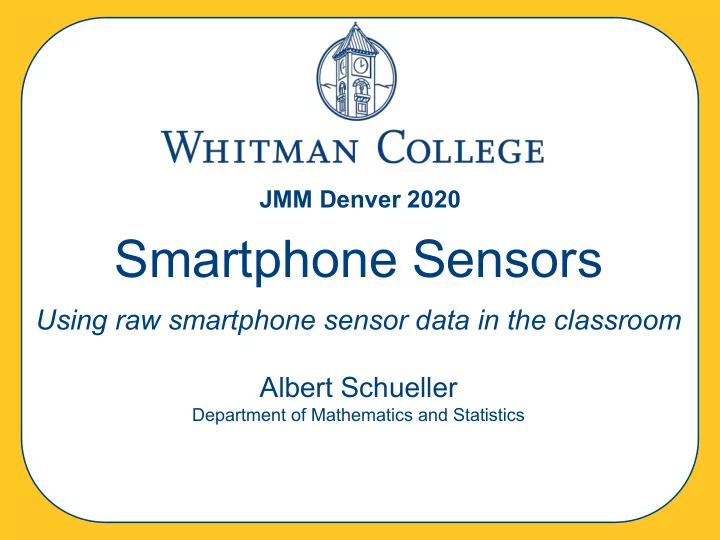

JMM Denver 2020 Smartphone Sensors Using raw smartphone sensor data in the classroom Albert Schueller Department of Mathematics and Statistics
Overview Introduce a collection of useful technologies that have a broad range of applications and that students will find motivating. ● Phone sensors and collecting raw data ● Jupyter/Python for analyzing raw data ● Mapbox, “free” mapping software ● Github, managing and distributing projects
Phone Sensors From: Majumder, S.; Deen, M.J. Smartphone Sensors for Health Monitoring and Diagnosis. Sensors 2019, 19, 2164.
Raw Sensor Data
Measuring Height ● Use the accelerometer sensor data to measure the height of an object. ● Teaches the relationship between acceleration, velocity, and position.
The Fastest Mile: Data Collection ● Use the GPS sensor to record an exercise like walking, running or cycling. ● Teaches about noise, smoothing, average speed, concavity.
The Raw Data
Data Analysis Visualize the data to make sure you aren’t analyzing junk. ● Jupyter, Plotly, Mapbox (all free). ● Plotly on-line visualization of the data.
Data Analysis (cont’d) Question : Within this longer exercise, which mile-long segment was the fastest? Answer : brute force approach Question : Where’s the mathematics? Answer : all over the place In the math classroom, we must accompany data analysis with abstract mathematical analysis.
Mathematical analysis Define a time vs. position function: Define an average speed function:
Fundamental Theorem of Calculus, concavity Find fastest and slowest miles by differentiating and setting equal to zero: Or, use the FTC and think about concavity: Concavity allows student to make some qualitative observations.
Spin Cycle ● Using the accelerometer, we can measure the vibrations of a washing machine. ● A Fourier analysis extracts dominant modes of vibration. ● The dominant modes of vibration tell us how quickly the washing machine spins during its spin cycle.
Other Smartphone Sensor Projects ● Fitness and sleep tracking, accelerometer, GPS ● Respiratory health, cough monitoring, microphone ● Cardiovascular health, camera ● Weather prediction/monitoring, barometer ● Bone density, accelerometer ● Earthquake detection, accelerometer
Learning Resources How did I figure all of this out? ● Learned to program in Python. There are now many resources: books, on-line courses, videos to help one learn to program. ● Did a lot of DataCamp courses around data science using Python. ● Worked on small, low-stakes data science projects of my own. e.g. crunched data from our office of institutional research. ● Worked on data science projects with students in our senior project course. ● Used (continue to use) Python data science tools to develop course materials and demos in my regular math classes.
Additional Resources ● Recent article by yours truly: Phone Sensor Data in the Mathematics Classroom article in PRIMUS (Aug 2019) ● Github Repository: https://github.com/schuelaw/PhoneSensorMath under development, send me your ideas! Thank you for coming! Questions? Albert Schueller Whitman College
Recommend
More recommend